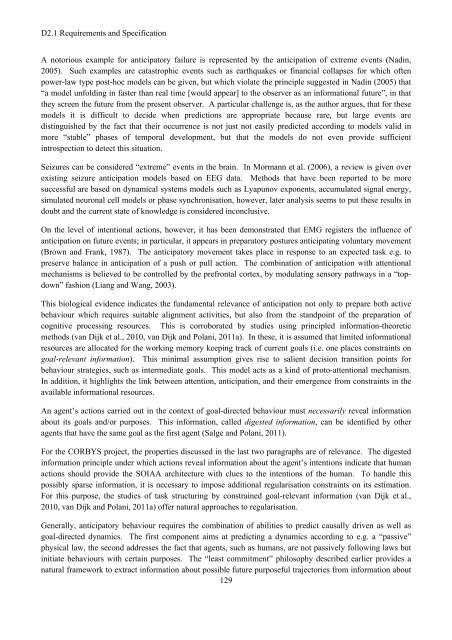D2.1 Requirements and Specification - CORBYS
D2.1 Requirements and Specification - CORBYS
D2.1 Requirements and Specification - CORBYS
Create successful ePaper yourself
Turn your PDF publications into a flip-book with our unique Google optimized e-Paper software.
<strong>D2.1</strong> <strong>Requirements</strong> <strong>and</strong> <strong>Specification</strong><br />
A notorious example for anticipatory failure is represented by the anticipation of extreme events (Nadin,<br />
2005). Such examples are catastrophic events such as earthquakes or financial collapses for which often<br />
power-law type post-hoc models can be given, but which violate the principle suggested in Nadin (2005) that<br />
“a model unfolding in faster than real time [would appear] to the observer as an informational future”, in that<br />
they screen the future from the present observer. A particular challenge is, as the author argues, that for these<br />
models it is difficult to decide when predictions are appropriate because rare, but large events are<br />
distinguished by the fact that their occurrence is not just not easily predicted according to models valid in<br />
more “stable” phases of temporal development, but that the models do not even provide sufficient<br />
introspection to detect this situation.<br />
Seizures can be considered “extreme” events in the brain. In Mormann et al. (2006), a review is given over<br />
existing seizure anticipation models based on EEG data. Methods that have been reported to be more<br />
successful are based on dynamical systems models such as Lyapunov exponents, accumulated signal energy,<br />
simulated neuronal cell models or phase synchronisation, however, later analysis seems to put these results in<br />
doubt <strong>and</strong> the current state of knowledge is considered inconclusive.<br />
On the level of intentional actions, however, it has been demonstrated that EMG registers the influence of<br />
anticipation on future events; in particular, it appears in preparatory postures anticipating voluntary movement<br />
(Brown <strong>and</strong> Frank, 1987). The anticipatory movement takes place in response to an expected task e.g. to<br />
preserve balance in anticipation of a push or pull action. The combination of anticipation with attentional<br />
mechanisms is believed to be controlled by the prefrontal cortex, by modulating sensory pathways in a “topdown”<br />
fashion (Liang <strong>and</strong> Wang, 2003).<br />
This biological evidence indicates the fundamental relevance of anticipation not only to prepare both active<br />
behaviour which requires suitable alignment activities, but also from the st<strong>and</strong>point of the preparation of<br />
cognitive processing resources. This is corroborated by studies using principled information-theoretic<br />
methods (van Dijk et al., 2010, van Dijk <strong>and</strong> Polani, 2011a). In these, it is assumed that limited informational<br />
resources are allocated for the working memory keeping track of current goals (i.e. one places constraints on<br />
goal-relevant information). This minimal assumption gives rise to salient decision transition points for<br />
behaviour strategies, such as intermediate goals. This model acts as a kind of proto-attentional mechanism.<br />
In addition, it highlights the link between attention, anticipation, <strong>and</strong> their emergence from constraints in the<br />
available informational resources.<br />
An agent’s actions carried out in the context of goal-directed behaviour must necessarily reveal information<br />
about its goals <strong>and</strong>/or purposes. This information, called digested information, can be identified by other<br />
agents that have the same goal as the first agent (Salge <strong>and</strong> Polani, 2011).<br />
For the <strong>CORBYS</strong> project, the properties discussed in the last two paragraphs are of relevance. The digested<br />
information principle under which actions reveal information about the agent’s intentions indicate that human<br />
actions should provide the SOIAA architecture with clues to the intentions of the human. To h<strong>and</strong>le this<br />
possibly sparse information, it is necessary to impose additional regularisation constraints on its estimation.<br />
For this purpose, the studies of task structuring by constrained goal-relevant information (van Dijk et al.,<br />
2010, van Dijk <strong>and</strong> Polani, 2011a) offer natural approaches to regularisation.<br />
Generally, anticipatory behaviour requires the combination of abilities to predict causally driven as well as<br />
goal-directed dynamics. The first component aims at predicting a dynamics according to e.g. a “passive”<br />
physical law, the second addresses the fact that agents, such as humans, are not passively following laws but<br />
initiate behaviours with certain purposes. The “least commitment” philosophy described earlier provides a<br />
natural framework to extract information about possible future purposeful trajectories from information about<br />
129


